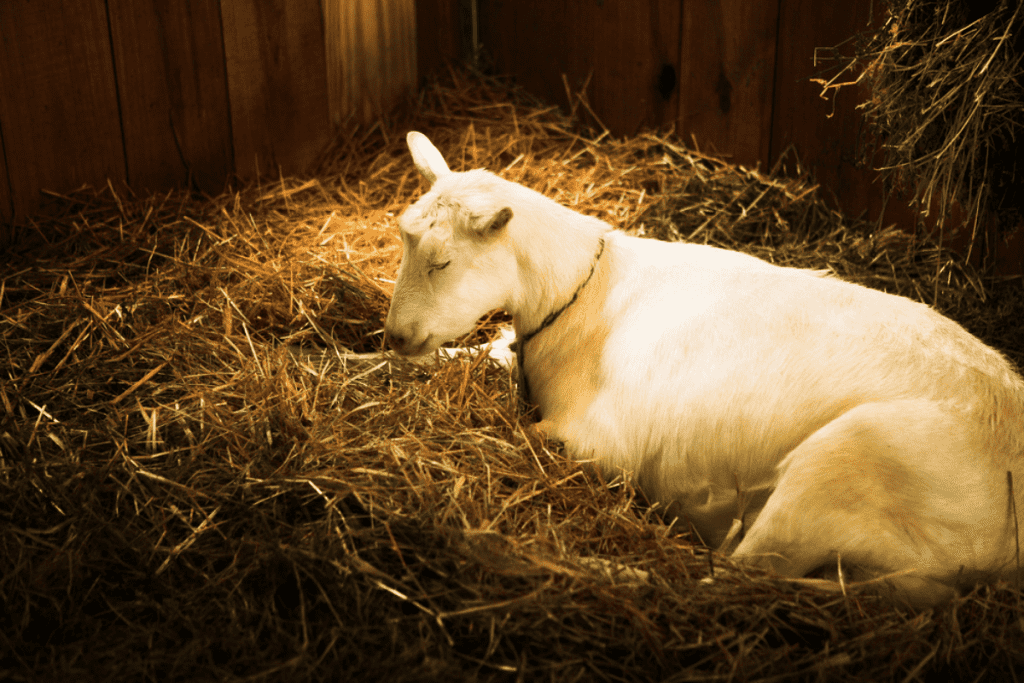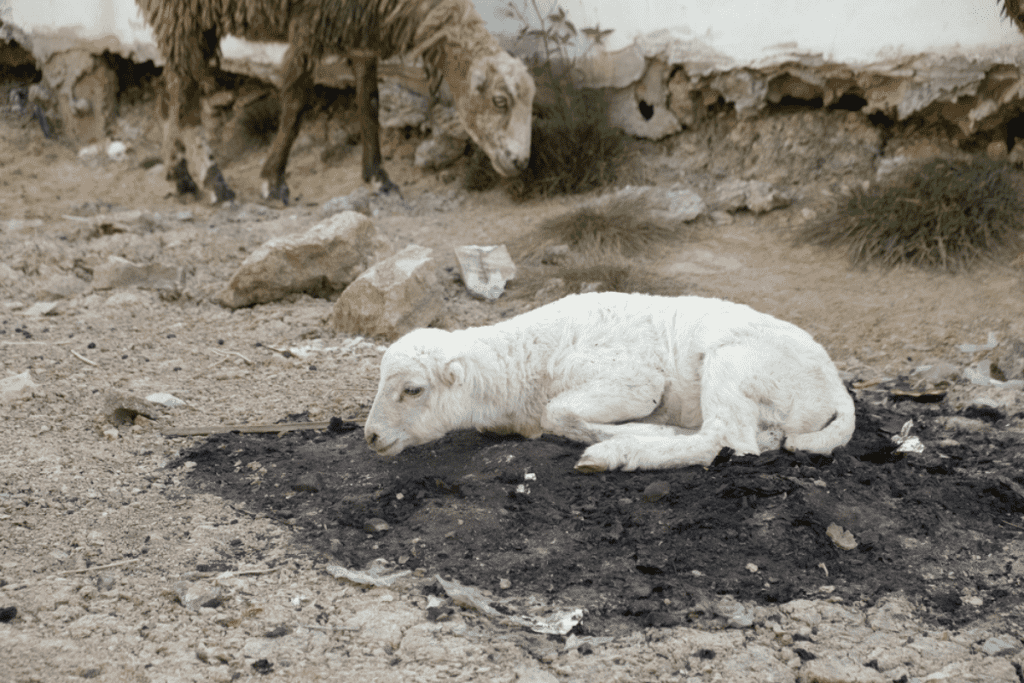Goats tend to be messy animals, and some owners struggle with choosing bedding materials for their barn.
The three main things to look for when deciding which bedding to choose for your goat are how absorbent the material is, how comfortable it is for your goat, and how easy it is to keep clean.
If a goat’s bedding is constantly dirty and wet, the animal is more susceptible to illnesses like respiratory infections, fungal infections, and external parasites.
Maintaining a goat’s bedding is especially important during the cold winter months.
While goats are typically hardy animals, drastic temperature changes will cause them to become stressed.
Sleeping on cold, wet bedding increases the chance of a goat developing pneumonia, which may be deadly for the animal if it is not treated quickly.
Keeping the bedding clean also lowers the risk of illness in your goats.
You will need to clean the goat pen every day and add fresh bedding to keep your goats healthy and comfortable.
While choosing bedding materials for your goats may be overwhelming, we have compiled this handy list of some of the best options and which ones to avoid.
Keep reading for more information on goat bedding, so you will be able to decide which material is best for your goat.
Table of Contents
ToggleTop 5 Best Bedding Options for Goats

Pine Shavings
Pine shavings are considered one of the best options for goat bedding due to their absorbency and easy removal of soiled areas.
Pine shavings are also soft under a goat’s feet and comfortable for the animal to lay on.
Pine bedding is sometimes combined with straw, and it is excellent at controlling odors.
It is easy to see soiled areas in pine shavings, making keeping the goat barn clean much more manageable.
Pine shavings are a very cost-effective bedding option, so you do not have to go over your budget to use them.
Soiled pine shavings may even be added directly to compost, so you will be able to use them as fertilizer later.
Read about goats eating pine needles in our article at the link.
Straw
Straw bedding is an excellent choice for goats because it readily absorbs moisture.
Dry bedding is best for a goat barn because it is less likely to harbor mold or harmful bacteria.
The hollow stems of straw bedding also help insulate goats against frigid weather, and it is a very popular bedding option in the cold months.
There are, however, a couple of drawbacks to using straw as goat bedding.
If straw gets too wet, it may become matted together, making it more challenging to keep clean.
Another problem with straw is some goats tend to eat it.
Most goats will not eat anything from the floor, but a few may not be as picky.
If you decide to use straw as a primary bedding component for your goats, you must monitor them carefully to ensure they are not eating it.
Eating soiled straw will very likely make your goats sick.
If your goats tend to eat straw bedding from the floor, you may want to reserve using it as a bottom layer for another bedding option, such as pine shavings.
Pelleted Bedding
Pelleted bedding is usually made from compressed wood, and it is very absorbent and easy to clean.
Unlike straw, your goats will not be tempted to eat pelleted bedding.
Pelleted bedding is also an inexpensive option and is available in several sizes.
The smaller pellets are a great choice for goats and chickens, and the larger ones work well for horses.
Pelleted bedding is usually mixed with rice hulls, sawdust, and corn cobs for extra absorbency.
The pellets may be used as the primary bedding or as a supplement underneath straw or pine shavings.
Sawdust
Sawdust is one of the most popular choices for goat bedding, and it is relatively easy to obtain.
You will usually be able to get sawdust from a sawmill for a very low price, and sometimes it is free.
Sawdust is a very lightweight, easy to clean, absorbent bedding and works well to prevent odors.
Using sawdust as bedding is very helpful in controlling ammonia in the goat enclosure.
Odor control is important because goats urinate very frequently, and they are prone to upper respiratory issues if the ammonia smell becomes too strong.
One of the only major problems with sawdust bedding is its tendency to attract parasites.
It is always good to make sure the sawdust does not contain any bugs before using it as goat bedding.
It is also recommended to use sawdust as a supplement to another type of bedding to cut down on the amount of dust it produces.
Hemp Bedding
While it is a relatively new option for goats, the benefits of hemp bedding are worth taking a closer look at.
Hemp can absorb up to four times its weight in liquids, and it does not mold easily.
This absorbency helps prevent odors and makes hemp very cost-efficient because it does not have to be changed as often as other types of bedding.
Hemp creates virtually dust-free bedding, which reduces the risk of your goats developing upper respiratory illnesses.
Hemp bedding is also softer than other bedding options, which is very comfortable for goats.
Soiled hemp bedding works very well for composting manure because it fully decomposes.
8 Goat Bedding Options to Avoid

Cedar Chips and Shavings
While cedar chips and shavings are highly absorbent and will help prevent pests, they should not be used as goat bedding for various reasons.
If a goat ingests too much cedar, it will become very sick.
Common signs your goat is ill from ingesting cedar include:
- Hypoglycemia
- Weight Loss
- Depression
- Lack of Coordination
- Death
In addition to being potentially toxic for goats, cedar chips and shavings are more expensive than other goat bedding options.
You may use cedar shavings in the corners of bedding areas to keep pests away as long as you ensure your goats cannot easily find and eat them.
Wood Shavings
While pine shavings are known as one of the best choices for goat bedding, other types of wood shavings are not recommended, especially if you do not know their origin.
In addition to cedar, several types of woods are toxic to goats.
Some varieties of spruce woods are especially bad for goats, and it only takes a small amount for your goat to become very sick.
Due to the potential toxicity of the needles, it is best to avoid any type of wood shavings made from spruce.
Wild cherry, juniper, black walnut, and yew are other woods toxic to goats.
Never use wood shavings for goat bedding if you do not know which types of wood they are made from.
Sand
Sand is not nearly as absorbent as other types of goat bedding, and it takes a long time to dry out.
Since the sand stays moist, it attracts parasites and becomes a breeding ground for bacteria.
The sand is very soft and comfortable for a goat, but it will also develop a buildup of urine and feces quickly and become very difficult to clean.
These factors create an unsanitary environment for goats and put them at a greater risk of developing illnesses and diseases.
Larger sand particles are also abrasive to goats and lead to cuts on their skin.
Sand works better as a bedding amendment underneath a bedding layer to provide drainage for more suitable material.
Wood Chips
Wood chips, also known as landscaping chips, are not recommended as bedding for goats.
The texture of wood chips is uncomfortable for goats, but they are also not very absorbent.
Wood chips will easily grow mold and mildew, which will cause respiratory illness and other health issues in goats.
Some wood chips will also stain a goat’s fur when wet.
Manure
Manure is ideal for your garden, but not as a goat bedding.
Wet manure becomes very muddy, creating a huge mess you will have difficulty cleaning.
Manure also has an odor and contains several types of bacteria, which may cause your goats to get sick.
The bacteria in manure also produce heat, which works well for protecting plants from cold weather.
However, this excess warmth may cause severe bloat and other digestive issues in goats.
Manure’s distinct smell will also attract flies and insects to the goat enclosure.
Pine Needles
More commonly known as pine straw, pine needles are different from pine shavings.
It is not recommended to use pine straw as goat bedding for several reasons.
Pine straw is not very absorbent, so it does not work well at handling large amounts of goat urine.
This will lead to a buildup of ammonia fumes, which are very bad for your goat.
Another reason to avoid using pine needles for goat bedding is their high flammability.
Pine needles catch fire very easily, creating an extremely hazardous condition for your goats.
Hay
Hay is often confused with straw, but they serve different purposes on a farm.
Hay is commonly used as a feeding supplement for livestock, and it is more expensive than straw, which is typically reserved for animal bedding.
Even though hay is very absorbent, it is more prone to growing mold and mildew.
Wet hay will also clump together and make cleaning the enclosure more difficult.
Grass Clippings
While grass clippings may seem like good bedding for goats because they are soft and readily available, they are actually a terrible choice.
Grass clumps together when it gets wet, and it is not very absorbent, so you will likely end up with a very messy and smelly stall.
There is also the potential for your goats to munch on the grass clippings, which will cause them to become bloated.
It is very dangerous for a goat to suffer from bloat, and it’s potentially life-threatening.
Grass clippings from a lawn treated with pesticides or fertilizers are also very dangerous to goats because of the harmful chemicals they contain.
How useful was this post?
Click on a star to rate it!
We are sorry that this post was not useful for you!
Let us improve this post!
Tell us how we can improve this post?
